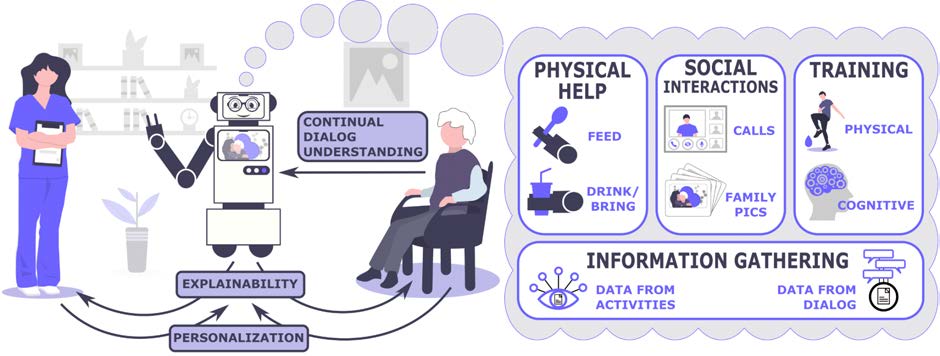
ROB-IN
Robot for continual personalized assistance able to explain itself
ROB-IB project PLEC2021-007859 funded by MCIN/ AEI /10.13039/501100011033 and by the European Union NextGenerationEU/PRTRT.
Robots are increasingly becoming a part of our daily lives and they are deemed to be a very effective tool to address current societal issues. Assisting older adults to age in place is one of those. Robots can improve user well-being, mitigate the problems of ageing, maintain independence, and will also serve for monitoring and early diagnosis of potential physical and mental issues. In our view, robots will be tools that will support older adults to age in place but also will enhance caregivers' effectiveness in providing better care. This is a novel concept in which the robot is designed to serve several purposes at the same time.
Having a robot at home during the whole day will create new human-robot relationships, where the robot provides assistance by performing activities but also where the robot monitors and understands human activity. In this new paradigm, the robot can answer to human commands, but also must proactively start interactions. The robot can also communicate with the caregiver who can introduce some patterns in the robot behaviour and receive reports that inform of changes in habits and routines of the older adult.
Despite the large efforts devoted to research and development in social and assistive robots, robots have not been there when needed, like in the recent COVID pandemics. We believe that robot perception and action technology is there, and what is missing is the appropriate intelligence.
In this project we aim to develop new enabling technologies in three core aspects: personalization, continual dialogue understanding and explainability: Personalization because robots must make decisions that adapt to the user and the caregiver needs and preferences; Continual dialogue understanding because the most natural interactions are conversations where the robot can extract useful information about the user both by asking questions or maintaining small talk dialogues; Explainability because users need to build trust by understanding why the robot takes particular decisions and what data the robot is gathering, providing mechanisms for privacy control.
The particular applications we envisage will form the initial set of the robot abilities, which will be enlarged with the insights provided by caregivers and elders in a user-centric design approach. We will focus on activities of: 1) physical help, like bringing items, help to feed and help to drink; 2) engagement in social interactions, like inducing calls to relatives, showing family photos; 3) encouragement of physical and cognitive training, by using the robot to administer and evaluate particular exercises; and 4) information gathering to help the caregiver. By observing and measuring task parameters and learning from dialogs the robot can provide valuable information that can be used by caregivers to improve early assessment.
We have gathered a strong multidisciplinary team with caregivers (SUARA), roboticists (CSIC), natural language experts (UPC) and data analysis developers (DATISION). The main impact of the project is in the new economic opportunities that will be created, but more importantly, in the change of people’s way of life.
